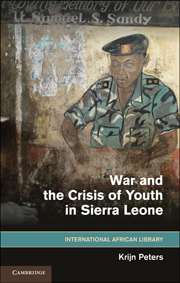Book contents
- Frontmatter
- Contents
- Acknowledgements
- Abbreviations
- Introduction
- 1 Voices from the Battlefield: Ex-Combatants' Views on Root Causes of the War and Their Reasons for Participation
- 2 The Socio-Economic Crisis of Rural Youth
- 3 Conflict in Sierra Leone and Recruits to the War
- 4 The World of the RUF
- 5 Malfunctions and Atrocities
- 6 Cultivating Peace: RUF Ex-Combatants' Involvement in Post-War Agricultural Projects
- 7 Footpaths to Reintegration? Agrarian Solutions for the Reintegration of Ex-Combatants
- 8 Conclusion: The RUF as a Rural Underclass Project
- Epilogue
- Annex I A Chronology
- Annex II Overview: Interviewed Ex-RUF Combatants
- References
- Index
- THE INTERNATIONAL AFRICAN LIBRARY
5 - Malfunctions and Atrocities
Published online by Cambridge University Press: 03 May 2011
- Frontmatter
- Contents
- Acknowledgements
- Abbreviations
- Introduction
- 1 Voices from the Battlefield: Ex-Combatants' Views on Root Causes of the War and Their Reasons for Participation
- 2 The Socio-Economic Crisis of Rural Youth
- 3 Conflict in Sierra Leone and Recruits to the War
- 4 The World of the RUF
- 5 Malfunctions and Atrocities
- 6 Cultivating Peace: RUF Ex-Combatants' Involvement in Post-War Agricultural Projects
- 7 Footpaths to Reintegration? Agrarian Solutions for the Reintegration of Ex-Combatants
- 8 Conclusion: The RUF as a Rural Underclass Project
- Epilogue
- Annex I A Chronology
- Annex II Overview: Interviewed Ex-RUF Combatants
- References
- Index
- THE INTERNATIONAL AFRICAN LIBRARY
Summary
Introduction
In Chapter 4 I presented evidence to suggest that the world of the RUF was more organised than has hitherto been recognised. The movement had a political programme, and made attempts to implement it. These attempts continued into the chaotic latter stages of the war. I pointed out, in particular, that the movement had a set of rules and regulations and a guiding ideology which it sought to instil in its fighters during their training period, and a rather elaborate intelligence apparatus mandated to monitor and correct their behaviour. How then did it go so horribly wrong? Why were so many civilians harassed, raped, subjected to amputation, and killed, and so much property looted or burned – when the movement's original aim had been to reform the country?
No one should try to deny that the RUF committed serious atrocities during its decade-long struggle. When Foday Sankoh returned to Sierra Leone in March 1999, he himself apologised for these grievous ‘errors’. There has been a misleading tendency, however, to attribute all the atrocities that took place during the war to the RUF. Keen (2005: 267) has argued that the RUF was not only a movement but also an environment useful to various actors who undertook violent outrages while at the same time putting the blame on the RUF.
There are several more conventional explanations for the movement losing its way, but these all leave questions unanswered.
- Type
- Chapter
- Information
- War and the Crisis of Youth in Sierra Leone , pp. 138 - 175Publisher: Cambridge University PressPrint publication year: 2011

